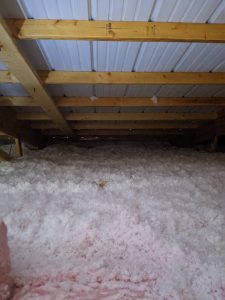Multiple options are available for insulating attics of post frame (pole barn) attics. Reader NATE in BURNHAM writes:
“Hello! I have been doing some research all evening and I can’t seem to find an answer. I did take the time to read some various forums and blogs regarding this subject to no avail…having said that, here is my question; According to the attached spec sheet for my roof trusses (4ft O.C) spanning my 52Lx28Wx10H pole building, would blown in cellulose insulation at an R38 value combined with 6ml plastic sheeting (vapor barrier) and thin gauge metal ceiling be supported? I do know from the specs that my BCDL is 5psf. Any help on this would be wonderful as I am at a stopping point in finishing my garage. Thank you!”
Mike the Pole Barn Guru advises:
I am going to hopefully change some of your plans here….
Unless your building is where there are 8000 heating degree days or more, you should not have a ceiling vapor barrier (no 6ml plastic sheeting). In Pennsylvania you are well under this requirement (Northern Minnesota would qualify). You do need to have sufficient eave intake and ridge exhaust ventilation to allow warm moist air from inside of your building to be vented out above your insulation. Your total NFVA (Net Free Ventilation Area) must be no less than 699 square inches, with at least 50% and no more than 60% located at the sidewall eaves.
 Blown in cellulose weighs roughly 2.5 to 3 pcf (pounds per cubic foot). Blown in cellulose will settle as much as 20% and can take up to two years to do so. Cellulose gives R-3.5 per inch, so your R-38 would be 10.86 inches thick (after settle), so I would plan on no less than 13.5 inches blown in to achieve your R-38. To be safe, I would assume 3.4 psf (pounds per square foot). Besides settling, blown cellulose does have another downside – in order to be fire retardant it is treated with borax or boric acid. Borates can be corrosive to steel in humid or moist environments, so you may want to consider a different insulation type, such as fiberglass. Fiberglass is also lighter weight, coming in at about a pound per cubic foot.
Blown in cellulose weighs roughly 2.5 to 3 pcf (pounds per cubic foot). Blown in cellulose will settle as much as 20% and can take up to two years to do so. Cellulose gives R-3.5 per inch, so your R-38 would be 10.86 inches thick (after settle), so I would plan on no less than 13.5 inches blown in to achieve your R-38. To be safe, I would assume 3.4 psf (pounds per square foot). Besides settling, blown cellulose does have another downside – in order to be fire retardant it is treated with borax or boric acid. Borates can be corrosive to steel in humid or moist environments, so you may want to consider a different insulation type, such as fiberglass. Fiberglass is also lighter weight, coming in at about a pound per cubic foot.
Steel liner panels are most typically 29 gauge steel weighing in around 0.6 psf.
Your five psf BCDL (bottom chord dead load) has to also account, in part, for weight of your trusses and bottom chord bracing, as well as any electrical and light fixtures. Most often this is considered to be a pound per square foot. This is going to put your proposed use of cellulose right at capacity, without any remaining margin for error.






